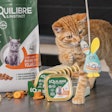
In 2007, more than half of Earth’s human population lived in urban areas for the first time. Urbanization continued, with more than a billion more people now living in cities and suburbs than in rural areas, according to United Nations Population Division figures presented by Our World in Data. People brought their desire for pets with them as they moved to cities, but changed some of their companion animal ownership preferences. For example, pet owners worldwide have trended towards smaller dogs and cats that work better with smaller living spaces in urban environments. This in turn influenced the pet foods and treats that owners buy. In October 2022, market analysis group TGM Research surveyed 15,000 of Earth’s 8.1 billion people in 40 nations about pet ownership. Although regional differences emerged, six trends emerged as effects of human urbanization on pet keeping.
Urbanization and pet ownership
Social Trends and Pet Humanization
“In urban areas, trends like pet humanization can take hold more rapidly,” Thuyen Vu, chief marketing officer, told Petfood Industry in an email. “According to our report, a significant 59% of consumers globally now acknowledge their pets as part of the family, while 22% regard them as friends, and 16% even equate them to children. This can lead to purchasing premium pet foods that are marketed with a focus on high-quality ingredients and health benefits.”
Increased Disposable Income
“Urban areas generally have higher living costs but also often higher wages,” Vu said. “This can lead to increased disposable income, allowing pet owners to buy premium pet food products that offer specialized diets based on age, breed, or health concerns. Our report identifies the top considerations influencing pet food purchases as quality (81%), cost (66%), ingredient composition (53%), and specific health needs of pets (50%).”
Higher Awareness of Health and Nutrition
“People living in urban areas may have greater access to information and are often more aware of the health and nutritional needs of their pets,” she said. “This could lead to a preference for organic, natural, or specially formulated pet foods. According to our report, 50% of consumers globally chose address specific needs/health concerns of their pet as one of the key factors for pet food purchase.”
Availability and Variety
“Urban pet owners have access to a wider variety of pet food products, likely influencing buying habits toward more diverse and specialized products,” Vu said. “This is shown from our pet care report with independent pet stores or small pet chain channels are the second most popular channel after supermarkets.
Online Shopping and Delivery Services
“With the proliferation of e-commerce, urban dwellers might prefer the convenience of ordering pet food online,” she said. “These shifts buying habits from in-store purchases to online shopping, with an emphasis on home delivery services. Online channel is the third popular channel where consumers purchase pet food in Europe, APAC and North America, according to TGM Global Pet Care Survey 2023.”
Environmental Concerns
“Urban consumers might be more environmentally conscious and could prefer pet foods that are sustainably sourced and have eco-friendly packaging. According to our report, 15% of surveyed consumers said a commitment to sustainability is a factor for their pet food purchase and this trend is higher across Asia-Pacific, Africa, and the Middle East and North Africa with 20%, 22% and 16% respectively”
















